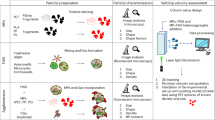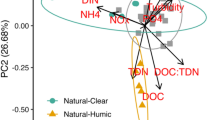Abstract
A simple computer code is presented for simulating the dependence of sulfate reduction on sulfate concentration using Monod kinetics. Unlike previous models, the code provides a numerical initial value problem solution, rather than a two-point boundary value solution, for the Monod model using a search procedure to find the correct starting value for the derivative of sulfate concentration with respect to depth. Accordingly the code is not restricted to cases where sulfate vanishes at finite depth but also can be used to model situations where organic matter is exhausted before total depletion of sulfate can occur. In such situations, the code demonstrates that profiles generated using Monod kinetics differ significantly from those generated using the simple sulfate-independent model proposed by Berner (1964), even when the asymptotic concentration of sulfate at depth remains well above the Monod saturation constant.
Similar content being viewed by others
References
Bagander L. E., 1977, In Situ Studies of Bacterial Sulfate Reduction at the Sediment-Water Interface,in Sulfur Fluxes at the Sediment-Water Interface—an In Situ Study of Closed Systems, Eh and pH: Department of Geology, University of Stockholm, Publication no. 1, p. 1–30.
Berner, R. A., 1964, An Idealized Model of Dissolved Sulfate Distribution in Recent Sediments: Geochim. Cosmochim. Acta, v. 28, p. 1497–1503.
Boudreau, B. P. and Westrich, J. T., 1984, The Dependence of Bacterial Sulfate Reduction on Sulfate Concentration in Marine Sediments: Geochim. Cosmochim. Acta, v. 48, p. 2503–2516.
Hallberg, R. A.; Bagander, L. E.; and Engvall, A. S., 1976, Dynamics of Phosphorus, Sulfur and Nitrogen at the Sediment-Water Interface;in J. O. Nriagy (Ed.), Environmental Biogeochemistry: Ann Arbor Science Publishing, Michigan, p. 295–308.
Ince, E. L., 1926,Ordinary Differential Equations: Longmans, Green and Co., London. p. 558.
Jorgensen, B. B., 1983, The Microbial Sulfur Cycle,in W. E. Krumbein (Ed.) Microbial Geochemistry: Academic Press, New York, p. 91–124.
Lentini, M. and Pereyra, U., 1977, An Adaptive Finite-Difference Solver for Nonlinear Two-Point Boundary Problems with Mild Boundary Layer: Soc. Indus. Appl. Math. J. Numer. Anal., v. 14, p. 91–111.
Martens, C. S. and Berner, R. A., 1977, Interstitial Water Chemistry of Anoxic Long Island Sound Sediments. I. Dissolved Gases: Liminol. Oceanogr. v. 22, p. 10–25.
Monod, J., 1949, The Growth of Bacterial Cultures: Ann. Rev. Microbiol., v. 3, p. 371–394.
Ramm, A. E. and Bella, P. A., 1974, Sulfide Production in Anaerobic Microcosms: Liminol. Oceanogr., v. 19, p. 425–441.
Speckhart, T. H. and Green W. L., 1976, A Guide to Using CSMP—The Continuous Systems Modeling Program: Prentice-Hall, Englewood Cliffs, New Jersey, p. 325.
Author information
Authors and Affiliations
Rights and permissions
About this article
Cite this article
Gardner, L.R., Lerche, I. Simulation of sulfate-dependent sulfate reduction using Monod kinetics. Math Geol 19, 219–239 (1987). https://doi.org/10.1007/BF00897748
Received:
Accepted:
Issue Date:
DOI: https://doi.org/10.1007/BF00897748




